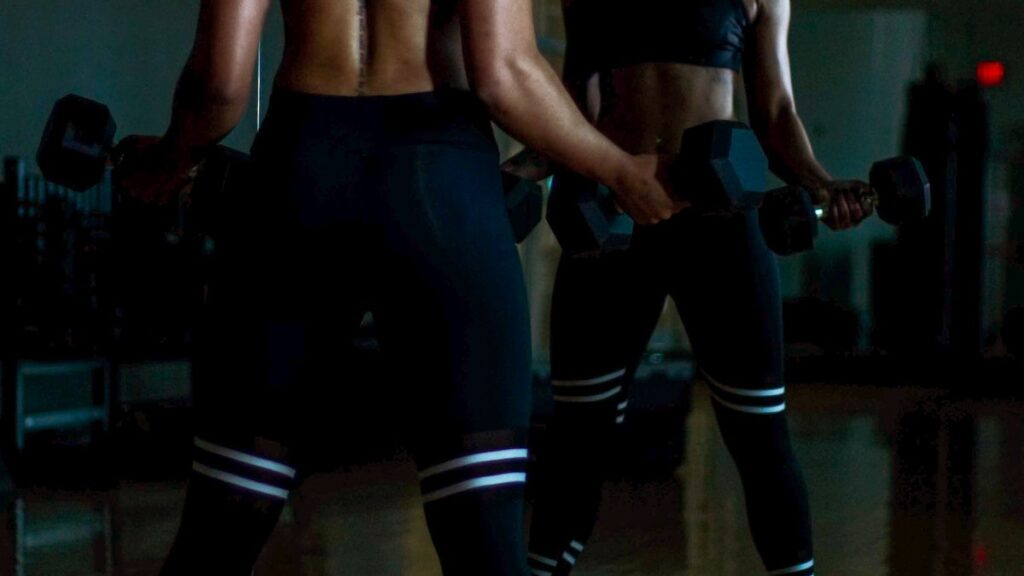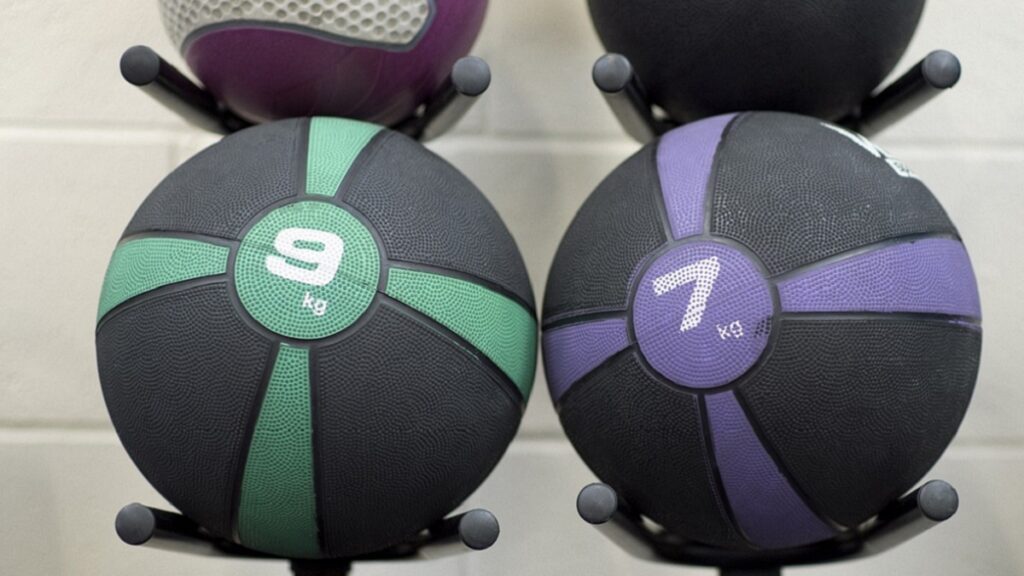The dumbbell lateral raise makes your shoulders appear larger and your waist thinner, improving your physique’s appearance. The aesthetic effect of building your shoulders is similar to wearing shoulder padding on a shirt or jacket.
Your hips and waist will appear thinner because your shoulders will appear larger. The dumbbell lateral raise also works out the muscles that support and stabilize your shoulders.
During DB lateral raise, you work Deltoid muscles, including lateral, anterior, and posterior deltoids. Core, trapezius, and serratus ante muscles aid in support. You can do DB lateral raises safely by lifting dumbbells side by side to a position where your hands are parallel to the ground.
Although performing lateral dumbbell raises seems simple enough, you elevate your arms while holding a pair of dumbbells. Knowing the DB lateral raise muscles worked to avoid injuries is also crucial.
DB Lateral Raise Muscles Worked
Although the lateral raise mainly targets the lateral deltoid, all three deltoid muscles are targeted here because it targets each shoulder head.
The lateral raise is one of the best shoulder workouts for developing broader shoulders like boulders. It’s also a straightforward exercise; you must raise the weights to the sides and shoulder level, then drop them again. Of course, we have much more specific instructions for maintaining proper form.
Lateral Deltoid
The primary function of the lateral deltoid, located on the outside of the shoulder, is shoulder joint abduction, which allows you to raise your arm to the side.
Like these lateral deltoid workouts, you make the same motion when performing a lateral rise. You must gradually build side shoulder muscle to get broad, rounded shoulders.
Anterior Deltoid
The main functions of the front shoulder include internal rotation, flexion, and horizontal flexion of the shoulder joints. When you finish your chest workouts for the week, like the bench press, you usually hit the anterior deltoid sufficiently. That’s because it’s included in most pushing activities, like these front deltoid exercises.
Although considerably less than the side delt, the front delt is also targeted by lateral raises.
Posterior Deltoid
The posterior deltoid, located on the shoulder’s back, performs the opposite functions of the anterior shoulder. Rear delt workouts include external rotation, extension, and horizontal extension of the shoulder joint.
Most pulling exercises, including the bent-over row, use the back shoulder muscles.
Muscles Supporting the DB Lateral Raise
During the upward phase of the exercise, the side lateral raise also stimulates and activates additional supporting muscles such as the serratus anterior, upper traps, and lower traps.
Seratus Ante
For this reason, the serratus anterior, also known as the boxer’s muscle, aids in enlarging the chest’s circumference. It aids in lifting the ribs when moving and, fundamentally, when breathing. It’s situated on either side of the ribs.
Trapezius
On the other hand, the upper and lower traps of the back support and move the scapula or shoulder blades. The majority of arm and chest exercises make use of it because it has a significant impact on how the shoulders move. The traps connect the spine, significantly impacting posture and safeguarding your backbone.
Core
The side lateral raise is one of the most effective exercises when the core’s stabilizer muscles are engaged. Your core has to be active to maintain good posture and prevent your back from arching. During this workout, your core muscles help stabilize your body to ensure appropriate form and safety.
What Muscles Are Used in DB Lateral Raises?
Lateral raises work the deltoid muscle group in your shoulders, especially the anterior and lateral deltoid and the trapezius muscles in your upper body.
When performed correctly, lateral raises increase the range of motion and promote hypertrophy, the process of muscles growing. Build your strength for more demanding workouts like barbell bench and shoulder presses by doing lighter dumbbell movements like lateral raises.
How to Do the Lateral Raise
Start with a weight you can control for 2-3 sets of 8–12 repetitions for the lateral raise. Pick a weight that enables you to use the proper form for all sets and repetitions.
- Standing with your feet hip-width apart and a slight bend in your knees, grab two dumbbells. You should bend your hips slightly forward, and your head and neck should be neutral. Your shoulders and hips should be just slightly apart. The chick should be tucked as if carrying an egg throughout the movement. Put equal amounts of weight on each foot.
- To create a secure foot position, grip the ground with both feet. Your hands should face your legs while you hold the dumbbells at your sides. The inside of your outer leg should be where your palms are positioned. Bending slightly in the elbows with stretched arms is excellent. Start each repeat from this location.
- While tensing your core, tense your shoulders and hips.
- Start the upward motion by bringing your arms slightly away from your body. Permit the shoulder joint and the shoulder blades to move normally. Continue raising your arms until your elbows are below or at shoulder height. Your shoulders ought still to be tense. At the peak of the motion, turn your palms so they are facing the floor.
- At the peak of the motion, pause.
- Lower the dumbbells toward your legs in the same plane as you lifted them. Maintaining tension in your shoulders, return to the starting position before beginning a new repetition.
What are Better DB Front Raises or Lateral Raises?
DB lateral raises are better than front raises because they have many other fantastic advantages besides giving you gorgeously rounded shoulders.
Contributes to Shoulders that are Rounded and More Muscular
Iteratively working your side shoulders will give you a V-taper look. Consider this: Your shoulders serve as the starting point for your definition. Thus, the wider they are, the more defined your V-look will appear.
The rest of your body will also seem better; the bigger, wider, and more rounded your shoulders become.
Increases Joint Stability, Flexibility, and Shoulder Strength
The DB lateral raise muscles worked are essential for overall shoulder health, much like how they played a significant role in developing your beautiful body, as we just covered. They support stabilizing the shoulder joint by preventing muscle imbalances.
Additionally, this joint is vulnerable to injury because it’s the body’s least stable and most mobile joint. Strengthen your surrounding muscles to maintain the joint’s flexibility, stability, and strength.
Enhances Compound Movement Performance
Most pushing and pulling motions require the shoulder muscles to be engaged. A muscular shoulder imbalance occurs with lateral delts because they aren’t addressed in many critical compound exercises. In that case, it leads to muscle compensation and weakness.
And you’ll discover that your main compound workouts will be more difficult if your shoulders become unbalanced.
Where Should You Feel a Lateral Raise?
The DB lateral raise muscles worked give your shoulder area more width and definition. Numerous adaptations are available for this exercise, which are beneficial for growing muscle. That will enable you to work out the muscles using various equipment and angles.
You can strengthen your trapezius and deltoid with this single workout. The simplest form entails rotating and pulling weights up and out from your body. Resistance bands, cables, weight plates, dumbbells, or anything else that is heavy or generates resistance can all be used for lateral raises. This exercise is frequently included in upper-body workouts combined with push-ups, pull-ups, or presses.
Do Lateral Raises Train Your Lats?
Yes, lateral raises can aid in lat training. An upper-body isolation exercise that targets the shoulder muscles is a lat lift.
Dumbbells, cable pulleys, or a lateral raise machine at the gym can all be used to execute lats, also known as lateral raises. For beginners, these can also be done without any weight.
Because lat raises work the deltoid muscles in the shoulder, they may be advantageous for your fitness regimen. You can also avoid injuries on your shoulders by strengthening the deltoid muscles. They aid you in pushing, pulling, and lifting the things you use daily.
Are Dumbbell Lateral Raises Good?
Yes, DB lateral raises are good for muscles. They’re crucial for minimizing muscle imbalances in your upper back and giving you shoulders that seem well-rounded and powerful. The lateral raise impacts the side shoulder, which doesn’t get as much attention as your anterior and posterior delts.
You will experience issues if you exercise your front and rear shoulder muscles. You may build key stabilizing muscles while adding muscle mass by performing lateral raises. Give yourself enough rest as part of the muscle-building process to aid muscle recovery.
Are DB Lateral Raises Good?
Lateral raises are excellent shoulder-building workouts! They entail an easy motion usually carried out with weights.
If performed consistently and correctly, lateral raises give your shoulder area more width and definition. Numerous adaptations are available for this workout, which has a high rate of muscular growth. That will also enable you to work out the muscles using various equipment and angles.
Naturally, you must master the right form for lateral rises and prevent frequent faults, as with any exercise.
What are Muscle Mistakes Common in DB Lateral Raises?
Here are a few errors on DB lateral raise muscles worked to watch out for.
Lifting Too Much Weight
Side lateral raises, including solitary exercises, typically don’t require using the largest weights. Choose lesser weights that allow you to perform 8 to 12 reps per set.
Increase the weight to achieve muscular growth if you reach 12 without experiencing side shoulder burn. Just be careful not to increase it to the point where you need to use other muscles to lift them.
Using Momentum Instead of Muscle When You Lift
Remember the improper technique we just mentioned while utilizing hefty weights? When you lift heavily, the dumbbells swing rather than being raised gently by the shoulder muscles. Look for hints like tilting your trunk forward and backward or bouncing your knees to assist them in rising upward.
Both indicate that your legs are involved, significantly lessening the work required by your lateral deltoid head. Despite employing greater weights, you are less likely to exhaust your side shoulders to the point of hypertrophy. This exercise is also excellent for building muscle endurance.
Additionally, because the shoulder joint is the most mobile, launching your dumbbells upward dramatically increases your risk of a shoulder injury. Choose weights that allow you to move with slow control to do your shoulders a favor.
Going Too Quickly
The shoulder race with the best definition is won by a slow and steady pace as you raise and lower the dumbbells with control and repeat. You probably use momentum if you go through the motions too quickly.
Straining the Neck
Maintaining a neutral neck and a bold look is essential to the proper lateral raise form. Your neck is probably straining if you stare downward while executing the workout. Heavyweights and overly exhausted shoulders are other common indicators.
Correct your form so your neck returns to neutral and your sight remains straight ahead if you sense neck tension or your neck leaning forward. You should stop lifting weights as well. Keep in mind that this is not the best action to increase strength.
Involving our Traps
You do not want to engage your trapezius muscle with hefty weights during a shoulder isolation workout. If you see your shoulders slumping upward during the lateral lift, that’s a simple method to tell you’re doing it all wrong.
Lower your weights immediately if you can see or feel your shoulders tense while using dumbbells.
Use your mind-muscle connection as you exert effort on the sides of your shoulders, and visualize pushing the weights apart if you still feel your traps working after switching to lighter weights.
Lifting Excessively
On the lateral raise, people frequently lift their arms too high. They raise their arms laterally until their elbows are significantly higher than their shoulders. Avoid doing this. Just a few degrees short of paralleling your shoulders, stop your elbows. By moving past parallel with your shoulders, you begin to stress your traps rather than your shoulders.
Although it’s acceptable to work your traps, the lateral raise isn’t a trapezius exercise; instead, it’s designed to assist you in isolating and concentrating on the lateral head of your deltoid. The lift is made simpler by letting your traps take over because doing so releases tension in your shoulders.
Should I Use Heavy or Light Weights on Lateral Raises?
“Go heavy or leave!” Although it can be exceptionally motivating, this remark is not accurate. Not all body parts can be developed with highly intense training. The DB lateral raise is an exercise that can either make or break your shoulders.
A precise movement pattern and range of motion are necessary for an exercise like the lateral raise to reap the benefits, even though lifting hard during Bench Presses, Squats, and Deadlifts has its advantage in growing strength.
What do DB Laterals Work?
Both your triceps and your shoulder muscles are worked during a lateral rise. To complete this activity, you can either stand or sit with a dumbbell in each hand and your arms at your sides. Raise the dumbbells until your arms are parallel to the floor with your palms towards your body and your elbows slightly bent.
What Do Lateral Raises Work the Most?
The lateral deltoid muscles are the primary muscles worked in lateral rises. You’ll also engage your front deltoids and upper traps due to the rotating motion.
The serratus anterior, supraspinatus, and posterior (back) deltoid only slightly participate in lateral rises (muscle above your ribs and under your armpit).
You must exercise your shoulder’s front, side, and back muscles to see real muscle growth. This explains why lateral lifts’ spinning motion is so efficient. You can target these sides differently by trying various lateral raise variations.
Are Lateral Raises Better Seated or Standing?
Standing and sitting can be used for lateral lifts, although standing increases the intensity and engages more muscles than sitting.
Although the lateral rise might be a simple exercise, it’s also simpler to perform it incorrectly. You must perform it correctly to activate all the required muscles and prevent injuries.
FAQs
How Heavy Should a Lateral Raise Be?
You should always use light dumbbells for the lateral lift. Exercise should be done sparingly. If you do, some of the work will be transferred from your side delts to your traps. You don’t need to pay additional attention to the traps in this move; save them for your trap exercises.
Additionally, if you lift too much weight, you might need to use a portion of your lower body to acquire momentum. Drop your ego and weights for this one; it won’t help your side delts.
Wrapping Up
Capped shoulders are your one-way ticket out, thanks to the DB lateral raise. You can get the boulder-like shoulders, remarkable chest spread, and equally muscular arms you see in the gym by performing this powerful workout. DB lateral raise muscles worked are also great add-ons for larger shoulders to other shoulder exercises.
As illustrated above, you must perform DB Lateral Raise correctly to activate all the required muscles and prevent injuries.



